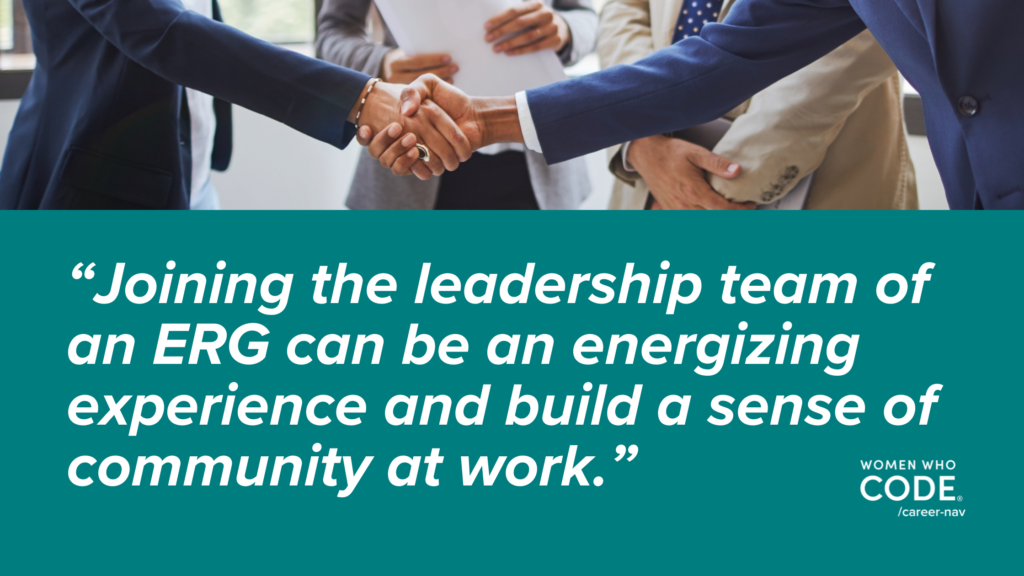Unlocking Your Leadership Potential in Employee Resource Groups (ERG)
Written by Anna Shur-Wilson

In addition to volunteering with organizations like Women Who Code, you may find that participating in an Employee Resource Group (ERG) can help foster community within your workplace and specific field. Getting involved or taking a leadership role within an ERG is also a great way to explore leadership.
Joining the leadership team of an ERG can be an energizing experience and build a sense of community at work. Still, it’s important to tackle the job with intention and patience to make sure the experience is empowering for both you and its members. When taking on this role, you may find established processes, functions, and roles within the group; however, you may need to help develop new processes and foster the group’s culture.
Here are some best practices I gathered based on my experience leading ERGs.
Empower Yourself and Others
Reflect on your motivations for pursuing a leadership role in your ERG. Sometimes, this community-building work within your organization’s corporate culture is not appreciated. If you thrive on recognition and celebration of success, create a mechanism if there isn’t one already.
Identify areas for training outside your day-to-day work (examples: communications and project management) for you and ERG members to practice additional skills to help with career growth. Also, conduct regular check-ins such as short, quarterly meetings and an end-of-year gathering to celebrate your successes and recognize the efforts of all the volunteers.
Define Structure for Volunteers and Decision-Making
Some ERGs create their own decision-making and hierarchies or fall under specific departments. It’s important to know who is the ultimate decision-maker for your group, whether the group leaders or someone on the corporate side.
If it’s up to the leaders in the group to create the structure, spend the first phase of your time as an ERG leader creating specific roles and job descriptions, including expected time commitment and what success looks like. Also, establish a process for navigating volunteer disagreements – a decision-maker or a non-hierarchical and consensus-building process.
Advocate for Compensation and Executive Sponsorship
In many organizations, leading an ERG is a volunteer role. However, growing evidence shows that compensating ERG leaders supports long-term DEI strategy and leaders’ additional work. As more companies begin to pay, one of your first steps may be to advocate for similar compensation. As you investigate the possibility of compensation, have a senior-level ally to advise you, research trends, and identify how it is beneficial company-wide. By having this executive sponsor, in addition to bringing recognition to your group’s mission, you’ll have someone to review your research and help it align with company goals and strategies.
This extra work deserves to be recognized not only monetarily but also when considering employees for promotions and raises. If you’re a people manager, consider employee ERG participation in their annual review.

Set Boundaries and Prevent Burnout
Due to global, local, and geopolitical events, identity and culture ERGs are asked to do things outside their normal purview in response. These requests can feel like a company is coming to ERG leaders to set priorities and policies, speak for entire communities, or solve internal issues. These large, complex, and emotionally draining tasks can lead to ERG leadership stress and burnout.
Use a sustainable model of prioritizing and setting clear goals, metrics, and boundaries for your group. You can use the SMART method (Specific, Measurable, Achievable, Relevant, and Time-Bound) for setting goals in the same way you might set goals in your annual review. Refer back to the goals often to ensure your group isn’t solving overwhelming problems and instead can focus on supporting its community. In particular, you may find that making sure that goals are achievable and relevant will help you manage expectations from corporate leadership and sustain your group long-term.
Recognize when it’s time to step down from leadership within your ERG. At the end of your tenure, you should have created a strong foundation for job descriptions and tenure of each position. As a leader, be resourceful and train your fellow members to take over. Also, continue to offer guidance when you step down. As a leader, knowing when to move on and allow others to grow is wise and shows your growth.